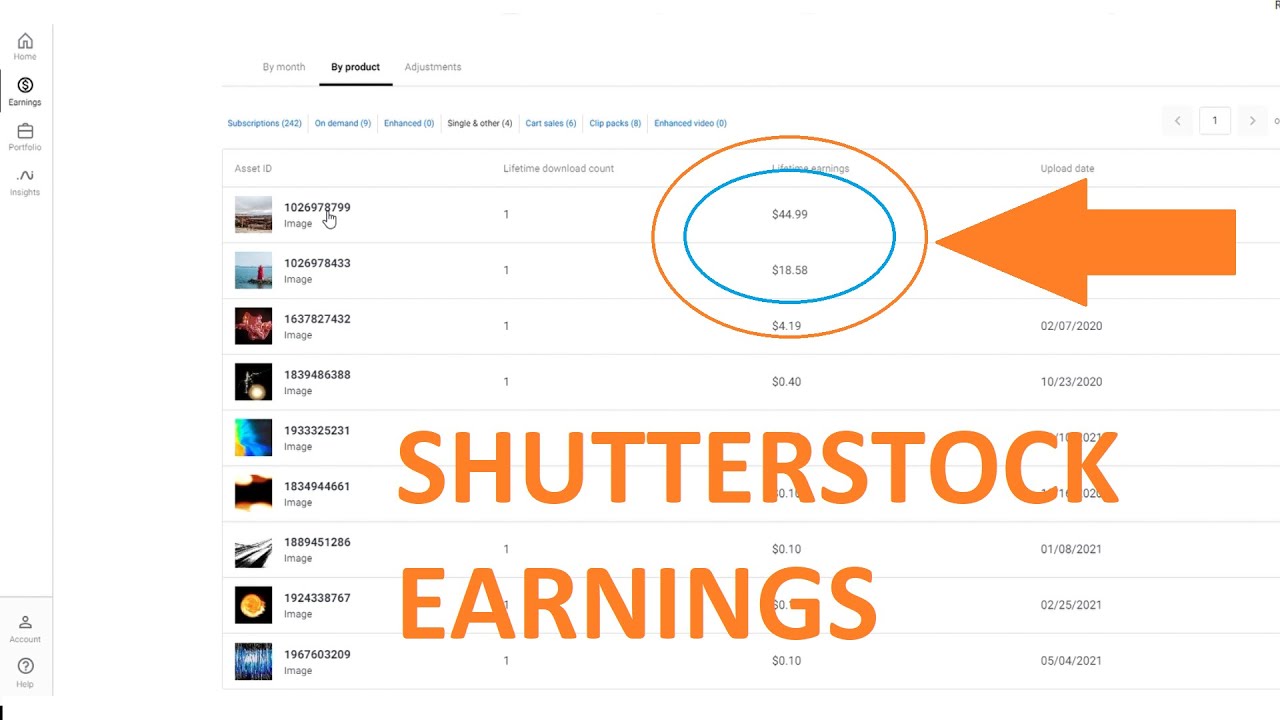Thinking about turning your creative work into a steady income stream? Shutterstock remains one of the top platforms for photographers, videographers, and graphic artists to monetize their assets. As we move into 2025, the process has become more streamlined, but also more competitive. Whether you’re a seasoned creator or just starting out, understanding how to navigate Shutterstock’s platform and meet its requirements is key to success. In this post, we’ll walk you through the essentials to help you start selling your assets confidently and efficiently this year.
Understanding Shutterstock’s Platform and Requirements

Before you upload your first asset, it’s important to get familiar with how Shutterstock’s platform works and what they look for in submissions. Shutterstock is a global marketplace where buyers come to find high-quality images, videos, and illustrations, so your submissions need to meet certain standards to stand out and be accepted.
Account Setup
Creating a contributor account is your first step. You’ll need to provide basic information such as your name, email, and payment details. Once your account is approved, you can start uploading your assets. Keep in mind that Shutterstock reviews every submission to ensure it aligns with their quality standards and content guidelines.
Content Guidelines and Quality Standards
- Resolution: Images should be at least 4 MP, but higher resolutions are preferred for better sales potential.
- File Formats: JPEG for photos, MP4 for videos, and AI or EPS for vector graphics.
- Originality: Your content must be original, not infringe on copyrights, and free of watermarks or logos.
- Model and Property Releases: For recognizable people or private property, proper releases are mandatory.
- Technical Quality: Sharp focus, good lighting, and minimal noise or artifacts are essential.
Categories and Keywords
Proper categorization and keywording are vital for discoverability. Use relevant, specific keywords to describe your assets accurately, making it easier for buyers to find your work. Avoid spammy or misleading tags, as they can lead to rejection or account issues.
Understanding Revenue and Licensing
Shutterstock offers different licensing options—standard and enhanced—that affect your earnings. Familiarize yourself with their payout structure and how your content will be licensed. Regularly check their contributor resource center for updates on policies, best practices, and tips to optimize your portfolio for better sales.
In summary, understanding the platform’s technical and content standards is crucial. Take the time to review Shutterstock’s contributor guidelines thoroughly and ensure your assets meet their quality benchmarks. This foundation will pave the way for a smooth submission process and increase your chances of success in the competitive marketplace of 2025.
Preparing Your Creative Assets for Submission
So, you’re excited to start selling your assets on Shutterstock? That’s fantastic! But before you jump into uploading, it’s super important to get your creative assets ready. Think of it like preparing ingredients before cooking — the better the quality and presentation, the more appealing your work will be to buyers.
First things first, make sure your assets are high quality. Shutterstock has strict standards, and they favor images, videos, and vectors that are crisp, clear, and professional-looking. Here are some tips:
- Resolution: For images, aim for at least 4 megapixels (preferably higher). For videos, HD (1920×1080) or higher is preferred.
- File formats: JPEG for photos, EPS or AI for vectors, and MOV or MP4 for videos. Always check the specific format requirements for each asset type.
- Color Profile: Use sRGB color space to ensure colors look consistent across devices.
- Editing: Remove any watermarks, logos, or distracting elements. Adjust brightness, contrast, and sharpness to enhance visual appeal.
Next, pay attention to your asset titles, descriptions, and keywords. Think about what buyers might search for. Be descriptive but concise, and use relevant keywords naturally. For example, instead of just “Sunset,” try “Golden sunset over mountain range with vibrant colors.”
Organize your files properly on your computer. Create a naming convention that makes it easy to identify and locate assets. This saves time during the upload process and helps you keep track of your portfolio.
Lastly, if you’re submitting images or vectors, consider adding a model or property release when necessary, especially if your work features recognizable people or private property. Shutterstock may require proof of releases for certain assets, so having these ready can speed up approval.
In summary, preparing your assets involves ensuring high quality, clear organization, and proper metadata. Taking these steps will not only increase your chances of approval but also attract more customers once your assets go live. Now, onto the next exciting step — creating your account and setting up your contributor profile!
Creating an Account and Setting Up Your Contributor Profile
Ready to get started? The first step is creating your Shutterstock contributor account. It’s straightforward, but taking some time to set up your profile properly can make a big difference in attracting buyers and building your reputation.
To create your account, head over to the Shutterstock Contributor Registration Page. Fill out the required information — your name, email, and create a strong password. You’ll also need to agree to their terms and conditions. Once registered, you’ll receive a confirmation email — be sure to verify your email to activate your account.
After logging in, it’s time to set up your contributor profile. Think of this as your storefront — it’s how buyers will see you and your work. Here are some tips for creating a compelling profile:
- Profile Photo: Upload a clear, professional-looking photo of yourself. It adds a personal touch and builds trust.
- Bio: Write a brief, friendly bio. Mention your background, what kind of assets you create, and your interests. Keep it authentic and approachable.
- Portfolio: Showcase some of your best work. Upload a few top-quality assets that represent your style and skills.
- Keywords and Tags: Use relevant keywords in your profile to improve discoverability. Think about what clients might search for when looking for assets like yours.
Don’t forget to link your social media profiles if you’re comfortable sharing them. This can help build your personal brand and connect with potential buyers or collaborators.
Once your profile is set up, review your account settings. Make sure your payment information is correct and up-to-date so you can receive earnings without any hiccups. Shutterstock offers multiple payout options, including PayPal and bank transfers, so choose what works best for you.
Finally, familiarize yourself with Shutterstock’s contributor guidelines and community rules. Understanding what’s expected will help you avoid common pitfalls and ensure a smooth submission process.
And that’s it! With your account created and your profile polished, you’re officially ready to start submitting your assets and making your mark on Shutterstock in 2025. Exciting times ahead — happy creating and uploading!
Uploading and Tagging Your Assets Effectively
So, you’ve got your assets ready—whether it’s stunning photos, eye-catching illustrations, or unique vectors. The next crucial step is uploading them properly and making sure they’re easy for buyers to find. Let’s break down how to do this effectively.
First off, when you upload your assets, quality is king. Ensure your files are high resolution, well-edited, and free of watermarks or clutter. Shutterstock prefers clean, professional-looking content that stands out. Pay attention to the format—JPEGs for photos, PNGs for transparent images, and EPS or AI files for vectors. Double-check the file sizes and dimensions to meet Shutterstock’s guidelines.
Now, on to tagging—this is how your assets get discovered. Think about what potential buyers will search for. Use descriptive, relevant keywords that accurately represent your asset. Instead of generic tags like “flower” or “car,” get specific: “pink peony flower,” “red sports car,” or “minimalist line art of a cat.”
Here are some tips for effective tagging:
- Use all available tags: Shutterstock allows up to 50 keywords per asset. Use them wisely!
- Prioritize relevant keywords: Place the most important tags at the beginning.
- Include synonyms and related terms: Different buyers might search differently—cover your bases.
- Avoid spammy tags: Don’t stuff irrelevant keywords just to get more views. It can hurt your reputation.
Besides tags, consider adding a clear, engaging title and a detailed description. These help improve search visibility and give buyers context about your asset.
Lastly, don’t forget to categorize your assets correctly. Proper categorization makes it easier for buyers browsing specific sections to find your work. Take a moment to review Shutterstock’s categories and choose the most fitting ones for each asset.
In summary, uploading high-quality assets with precise, thoughtful tags and descriptions will boost your chances of getting noticed and purchased. Take your time with this step—it’s worth the effort!
Optimizing Your Portfolio for Better Visibility and Sales
Once you start uploading assets, the journey doesn’t end there. To truly thrive on Shutterstock in 2025, you need to actively optimize your portfolio for better visibility and sales. Think of your portfolio as a storefront—making it appealing, organized, and easy to navigate will encourage more buyers to explore your work.
Here are some key strategies to optimize your portfolio:
1. Curate Your Best Work
Quality over quantity wins here. Focus on showcasing your strongest, most versatile assets. Regularly update your portfolio by removing outdated or less relevant items and adding fresh, trendy content. This keeps your portfolio dynamic and engaging.
2. Organize Assets into Collections
Create themed collections or portfolios within your main profile. For example, group all your cityscape photos, holiday illustrations, or business icons together. This makes it easier for buyers to find what they’re looking for and can lead to higher sales per visitor.
3. Use Consistent Branding and Style
If you have a particular style or niche, highlight it. Consistency helps build your brand identity and attracts clients seeking that specific look. Whether it’s minimalistic design, vibrant colors, or a specific subject matter, being recognizable can set you apart.
4. Engage with the Shutterstock Community
Participate in forums, comment on other artists’ work, and stay active. Engaging with the community can increase your visibility and help you learn trends or get feedback to improve your assets.
5. Leverage Analytics and Trends
Use Shutterstock’s analytics tools to see which assets perform best. Pay attention to trending topics and seasonal demands—adding assets related to current events or popular themes can give your portfolio a boost.
6. Promote Outside Shutterstock
Share your portfolio on social media, your personal website, or design communities. External promotion can drive targeted traffic to your Shutterstock profile, increasing the chances of sales.
Remember, building a successful portfolio is an ongoing process. Regularly review your work, adapt to market demands, and keep your portfolio fresh. With these optimization strategies, you’ll enhance your visibility and turn more viewers into buyers in 2025 and beyond!
Understanding Shutterstock’s Payment and Licensing Policies
Before diving headfirst into selling your assets on Shutterstock, it’s super important to get a clear picture of how their payment and licensing system works. This not only helps you set realistic expectations but also ensures you understand how you’ll earn and what rights you’re granting.
First off, let’s talk about payments. Shutterstock pays contributors on a monthly basis, typically around the 15th of each month, for the sales made in the previous month. Payments are made via PayPal or Skrill, so make sure your account details are up-to-date and correctly linked. The minimum payout threshold is usually $35, meaning you need to earn at least that amount before you can cash out. If you don’t reach it in a given month, your earnings roll over until they hit the minimum.
Now, onto licensing. When you upload assets, you’re granting Shutterstock a license to distribute your work under specific terms. They offer two main types of licenses:
- Standard License: Perfect for most uses like websites, blogs, or social media. It covers a wide range of uses but has limits on print runs (up to 500,000 copies). If your asset gets used for commercial purposes, this license might be the most common.
- Enhanced License: Designed for more extensive uses, such as merchandise, large-scale prints, or products for resale. This license allows for unlimited print runs and broader commercial use, but it also comes with a higher royalty rate.
Understanding these licenses is key because they determine how your assets can be used and how much you’ll earn per sale. For example, a standard license typically earns you a smaller royalty compared to an enhanced license. Be sure to read Shutterstock’s licensing policies carefully—knowing exactly what rights you’re granting helps prevent misunderstandings down the line.
Another thing to keep in mind is that Shutterstock’s policies can evolve. They occasionally update licensing terms or payment thresholds, so it’s a good idea to keep an eye on their contributor updates and FAQs. Staying informed means you can adapt your strategy and maximize your earnings while ensuring compliance with their policies.
Tips for Increasing Your Sales and Growing as a Contributor
So, you’ve uploaded a few assets and are waiting for those sales to roll in. It’s a good start, but if you really want to boost your earnings and become a successful contributor on Shutterstock, a few smart strategies can make a big difference.
Here are some tried-and-true tips to help you grow:
- Focus on Trends and Popular Topics: Keep an eye on what’s trending in the design world, current events, or seasonal themes. Creating assets that align with these trends can significantly increase your chances of being downloaded.
- Optimize Your Metadata: Use clear, descriptive titles, tags, and descriptions. Think about what keywords your potential buyers might use to find your work. The more accurate and relevant your metadata, the better your assets will rank in search results.
- Maintain Consistency and Quality: Upload regularly and ensure each asset is polished. High-quality, unique images stand out and attract more buyers. Invest in good equipment or editing tools if necessary.
- Diversify Your Portfolio: Don’t put all your eggs in one basket. Cover various themes, styles, and formats—photos, vectors, illustrations—so you appeal to a broader audience.
- Engage with the Community: Participate in forums, read other contributor blogs, and learn from successful creators. Networking can provide insights into what sells and how to improve your submissions.
- Leverage Social Media and Personal Branding: Promote your portfolio on social media platforms. Sharing your work can attract more attention and potential buyers outside of Shutterstock’s platform.
- Study the Competition: Look at top-selling assets in your niche. Analyze their style, composition, and metadata. Adapt successful elements into your own work while keeping your unique touch.
Growing as a contributor takes time, patience, and a willingness to learn. Keep experimenting, stay current with industry trends, and continuously refine your skills. Over time, your portfolio will become more diverse and appealing, leading to increased sales and a stronger presence on Shutterstock.
Staying Updated with Shutterstock’s Policies and Industry Trends in 2025
As you embark on your journey to sell assets on Shutterstock in 2025, one of the most important habits you can develop is staying informed about the platform’s policies and the broader industry trends. The world of stock photography, videography, and digital assets is always evolving—what’s hot today might be outdated tomorrow. Plus, Shutterstock updates its guidelines periodically to comply with legal standards and to ensure a positive experience for both creators and users.
First, make it a routine to check Shutterstock’s Contributor Resources page regularly. They often post updates about policy changes, submission guidelines, and new features. Subscribing to their newsletter is also a smart move—it’s a direct way to receive news and tips straight to your inbox.
Beyond Shutterstock, staying on top of industry trends can give you a competitive edge. Here are some ways to do that:
- Follow industry blogs and forums: Sites like Pond5, 500px, and Stock Photo Secrets offer insights into what’s trending and best practices.
- Use social media: Platforms like Instagram, Pinterest, and Twitter are great for spotting visual trends. Following popular creators and hashtags can give you ideas for what types of assets are in demand.
- Attend industry webinars and conferences: Virtual events or local meetups can help you network with other creators and learn about emerging trends and technologies.
Another key aspect is understanding legal and ethical considerations. Always ensure your assets comply with copyright laws, model releases, and Shutterstock’s content guidelines. Failing to adhere to these can result in rejected submissions or account suspension, which is the last thing you want.
Remember, the landscape is constantly shifting—what’s trending now might change by next year. So, staying adaptable and informed will help you remain competitive and successful as a Shutterstock contributor in 2025 and beyond.
Conclusion and Next Steps for Aspiring Shutterstock Sellers
Congratulations! You’re now equipped with a roadmap to start your journey as a Shutterstock seller in 2025. From understanding the platform’s requirements to staying updated on industry trends, you’ve got the foundation to build a successful portfolio of assets.
Here’s a quick recap of your next steps:
- Research your niche: Find what subjects or styles resonate with current market demand.
- Create high-quality assets: Focus on originality, technical excellence, and relevance.
- Optimize your submissions: Use descriptive, keyword-rich titles and tags to increase visibility.
- Stay compliant: Regularly review Shutterstock’s policies and ensure your assets meet all guidelines.
- Engage with the community: Join forums, webinars, and social media groups to learn and grow.
- Track your progress: Monitor your sales and adjust your strategy based on what performs well.
Remember, patience and persistence are key. Building a steady income stream from stock assets takes time and effort, but with consistent quality work and a proactive approach, you can turn your creative passions into a thriving business.
So, what’s next? Dive in, start creating, and don’t forget to keep learning. The digital marketplace is dynamic, and your adaptability will set you apart. Here’s to your success on Shutterstock in 2025 and beyond!


